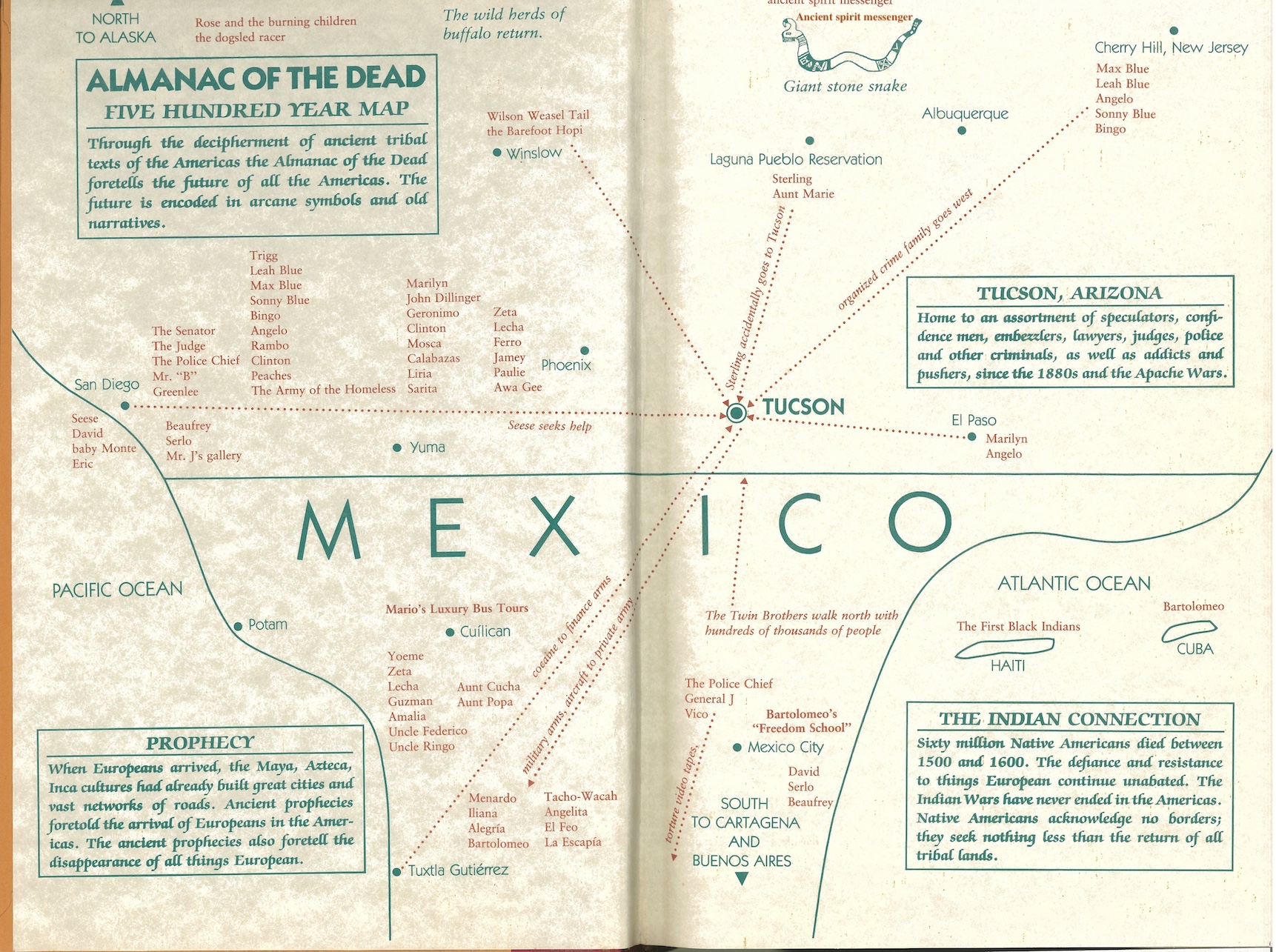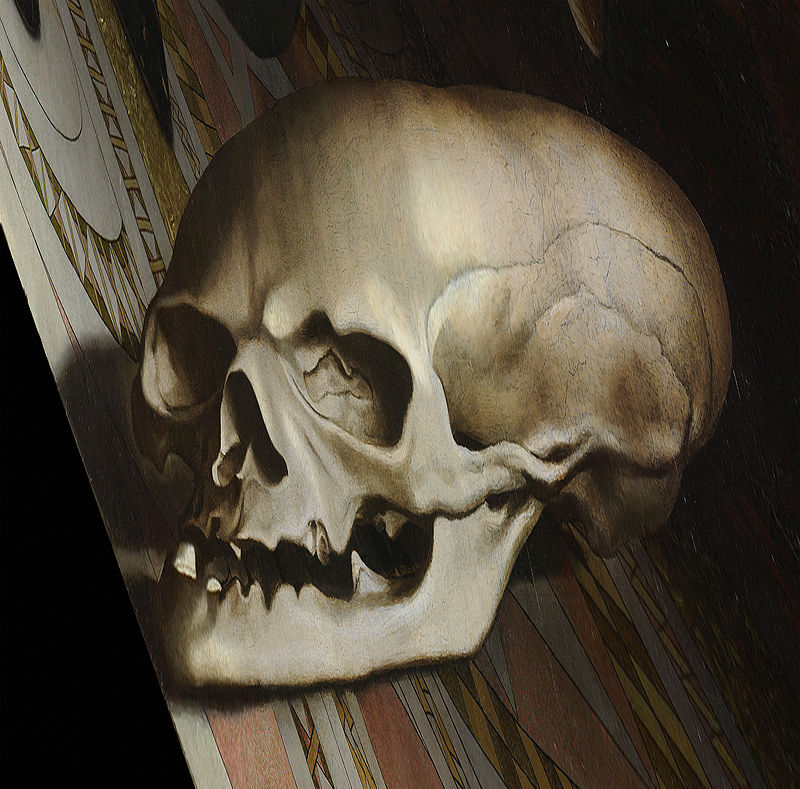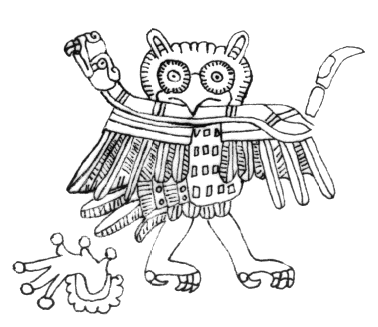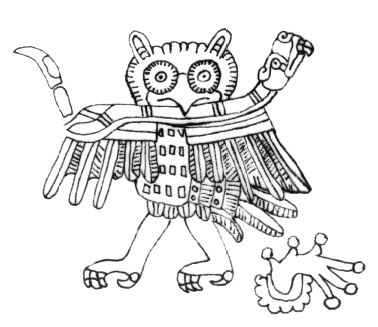"Almanac of the Dead takes place against the backdrop of the American Southwest and Central America. It follows the stories of dozens of major characters in a somewhat non-linear narrative format. Much of the story takes place in the present day, although lengthy flashbacks and occasional mythological storytelling are also woven into the plot./ The novel's numerous characters are often separated by both time and space, and many seemingly have little to do with one another at first. A majority of these characters are involved in criminal or revolutionary organizations - the extended cast includes arms dealers, drug kingpins, an elite assassin, communist revolutionaries, corrupt politicians and a black market organ dealer./ Driving many of these individual storylines is a general theme of total reclamation of Native American lands. " -Almanac of the Dead.
Five hundred year map; Through the decipherment of ancient tribal of theAmericas the Almanac of the Dead foretells the future of the Americas. The future is encoded in arcane symbols and old narratives.
Tuscon, Arizona; Home to an assortment of speculators, confidence men embezzlers, lawyers, judges, police and other criminals, as well as addicts and pushers, since the 1880s and the.Apache Wars.
Prophecy; When Europeans arrived, the Maya, Azteca, Inca cultures had already built great cities and vast networks of roads. Ancient prophecies foretold the arrival of Europeans in the Americas. The ancient prophecies also foretell the disappearance of all things European.
The Indian Connection;
Sixty million Native American died between 1500 and 1600. The defiance
and resistance to things European continue unabated. The Indian Wars
have never ended in the Americas. Native Americans acknowledge no
borders; they seek nothing less than the return of all tribal lands.
■テキスト:Almanac of the Deadによる
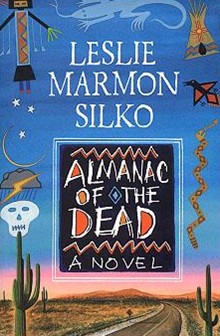
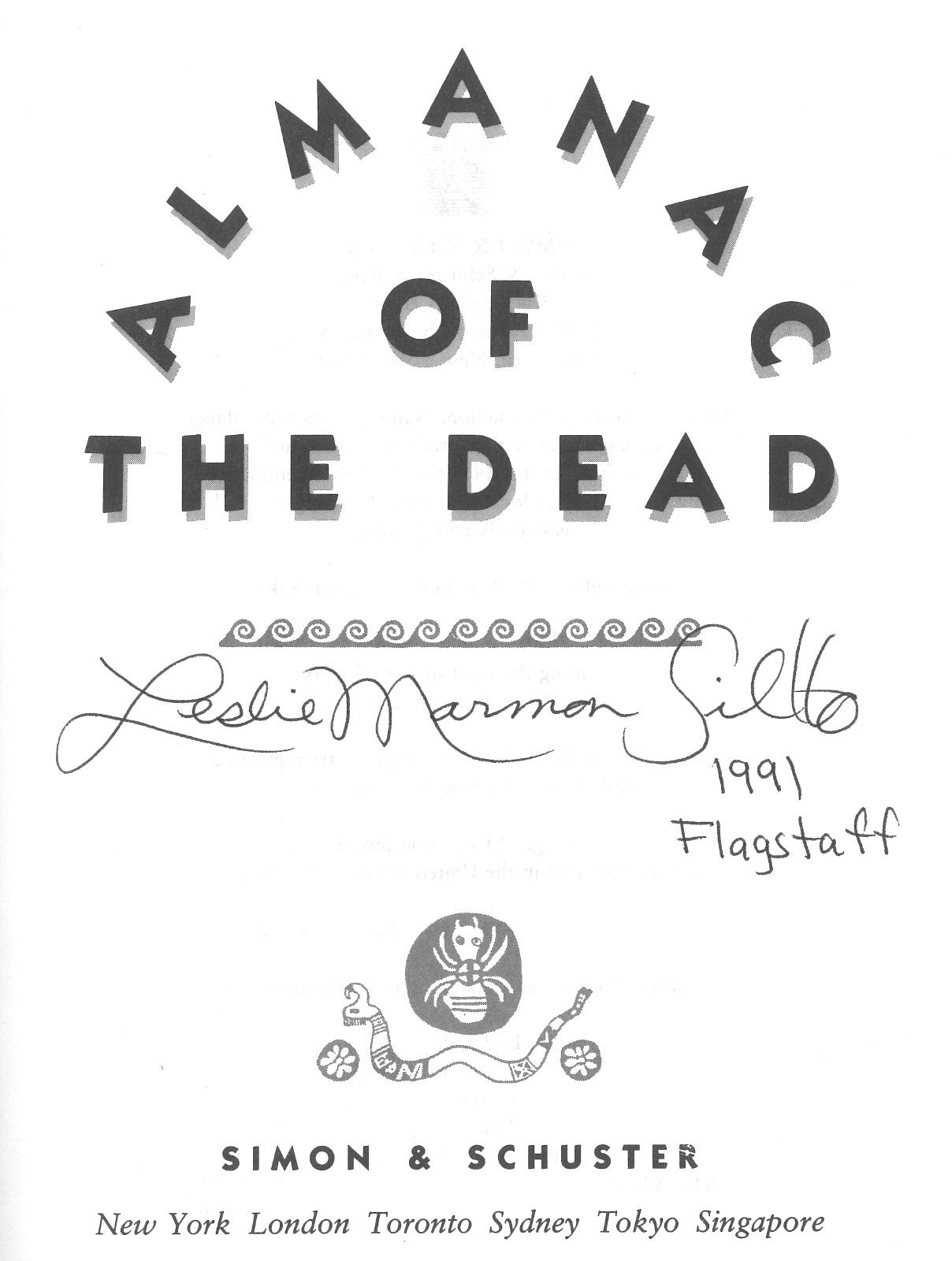
・死者の暦(1991)/ Flagstaff
で出版年に記された彼女のサイン(筆者蔵)
"Almanac of the Dead begins with a map before the reader actually engages with any sentences. The map is a simplified version of the borderlands of the American Southwest with various cities marked, yet Tucson is designed as being a sort of center of the region. There are all kinds of names and arrows on the outlined territories, but their meaning only begins to make sense as the reader moves forward in the novel. Silko's narrative takes place within this landscape, but Colombia also becomes a country where characters end up and others like Guatemala, El Salvador, Panama, and Honduras are alluded to. It depicts the lives of many characters throughout six parts that contain various numbers of "books", embedded with short chapters that almost function as interconnected short stories. The story does away with normative constructs of time, as the reader is usually placed or "dumped" into various scenarios or moments which come into sharper view as the book moves along. Much of the story takes place in the "present", although lengthy flashbacks and mythos tied to indigenous knowledge, are also woven into the plot."- Almanac of the Dead
Six parts that contain various numbers of "books"
Part One: THE UNITED STATES OF AMERICA
Part Two: MEXICO
Part Three: AFRICA
Part Four: THE AMERICAS
Part Five: THE FIFTH WORLD
Part Six: ONE WORLD, MANY TRIBE
| Part One: THE
UNITED STATES OF AMERICA |
Lecha、Zeta、Seese、
Sterling、Yoeme、Calabazas、Ferro、Paulie、David、Eric、Beaufrey、Jamey、Root、
Mosca、Mahwala、Sarita、Liriaが登場 |
||
| Book 01 |
Unanswered
Questions , Exile , The Stone Idols ,
The Ranch |
||
| BOOK ONE TUCSON page 19
Unanswered Questions , Exile , The Stone Idols , The Ranch BOOK TWO SAN
DIEGO page 42 TV Talk Show Psychic , Memories and Dreams Flying ,
Storms , Decoy , Texas , Miracle Mile The Stage Coach BOOK THREE
SOUTHWEST page 73 Famous Criminals , Business with Calabazas , In the
Backseat of a Chrysler , Sterling's Room , Hollywood Movie Crew , The
Water Bed , Old Aunt Marie , Banished , Working for Lech a BOOK FOUR
SOUTH page 101 Abortion , Suicide , Art , Kidnapped BOOK FIVE THE
BORDER page 114 Childhood in Mexico , Cottonwood Trees , The Failed
Geologist , Boarding School , Dried-up Corpse Coyote Years , At War
with the U.S. Government The Indian Way , Yoeme's Old Notebooks BOOK
SIX THE NORTH page 138 Locating the Dead , Lover's Revenge , Daytime
Television , Dogsled Racer , Tundra Spirits , Eskimo Television ,
Burning Children , Plane Crashes , Severed Heads , Sudden Retirement
BOOK SEVEN WEST TUCSON page 168 Root's Grandpa Gorgon , Root's Accident
, Shallow Graves , Arms Dealer , Lust , Memories , Drop Points , Mother
, The Weight of Ghosts , Falling Forever , Horse Races , Family , The
Happy Ones Tucson Witches , Homeless , Imaginary Lines BOOK EIGHT
INDIAN COUNTRY page 220 Resistance , Mistaken Identity , Old Pancakes
Wild Ones , , Two Sisters , Gambling Debt Marriage , The Monsignor ,
Journey of the Ancient Almanac PART TWO MEXICO page 255 BOOK ONE REIGN
OF DEATH-EYE DOG page 257 Mestizo , Universal Insurance , Tidal Wave ,
Arms and Munitions , Alegria , Iliana , Video Surveillance , Adultery ,
Marble Stairway , Love Tryst , High Risk , Exposed , High Command of
the People's Army , Air Force , Disgrace and Ruin , The Fall BOOK TWO
REIGN OF FIRE-EYE MACAW page 303 Terrorist Bombs , Communists , Comrade
La Escapia and the Cuban , Vampire Capitalists , Crimes Against History
, Bulletproof Vest , Reader of Dreams , General ]. , El Grupo Gun Club
, Strikes, Unrest, and Uprising , Blood Madness , Spirit Macaws ,
Police Interrogators PART THREE AFRICA page 347 BOOK ONE NEW JERSEY
page 349 Ambush , Wheelie , Blue Skies , Golf Game , Leah Blue , Desert
Real Estate , Family Business , Marilyn , Change of Heart , Venice,
Arizona , Steak-in-the-Basket , Diaries BOOK TWO ARIZONA page 387
Bio-Materials, Inc. , Green Beret , Plasma Donors , Army of the
Homeless , Vacant Houses First Black Indian , Spirit Power , Ogou, the
Knife Creole Wild West Indians , Army of Justice Liberation Radio
Broadcasts BOOK THREE EL PASO page 432 Sonny's Secret Sideline ,
Brother's Keeper , Organ Donors , Kill the Rich , .44 Magnum Has
Puppies , Men in Love , Jamey Love , Cop Cakes or Nude Cop Pinups ,
Owls Club PART FOUR THE AMERICAS page 465 BOOK ONE MOUNTAINS page 467
Angelita, aka La Escapia, the Meat Hook , Twin Boys , More Friends of
the Indians , Wacah the Spirit Macaw Interprets Dreams , Swarms of
Squatters , Village of Sorcerers and Cannibals , The Opal , Riots
Worldwide , Sonny Blue and Alegria , Emperor Maximilian and Charlotte ,
Unease and I I I I I I I I I I I Suspicion , Illegal Refugees , The
Test , Work of the Spirits , The Heat Is On , Miracle of High
Technology , How Capitalists Die , This Cuban Should Return to Cuba ,
Angelita La Escapfa Explains Engels and Marx , Sexual Rivals , On Trial
for Crimes Against Tribal Histories BOOK TWO RIVERS page 533 Mr. Fish,
the Cannibal , Sangre Pura , Alternative Earth Units , David's Infant
Son , Secret Agenda Biological Warfare , Baby Pictures , Lawsuits Games
, Bad News , Rapture of the Plain PART FIVE THE FIFTH WORLD page 567
BOOK ONE THE FOES page 569 From the Ancient Almanac , The Great
Infiuenza of 1918 , Old Yoeme's Advice , Family Cemetery , Adi6s, White
Man! , Great Lord Iguana , Cocaine Glut , Communist Priests and Nuns ,
Souls of the Dead , One Who "Reads" Body Fat , Tucson, City of Thieves
, Kilo of Cocaine , Barefoot Hopi , Close Call , A Series of Popes Had
Been Devils , The Hopi Has Answers for Everything BOOK TWO THE WARRIORS
page 628 Getting Old , Dead British Poet at Yaqui Easter Dance , Tucson
Police Brutality , Ambitions , Suitcases for Mr. B. , The Thursday Club
, The Young Police Chief , Golf Game , Beloved Basset Hounds , Tucson's
Sex Mall BOOK THREE THE STRUGGLE page 665 Luxury Cruise , A Short Walk
, Enemy Lightning , Solar War Machine , Turn Out the Lights! , Ferro in
Love , Undercover Special Assignment , Shoot-out at the Stage Coach ,
Scattered in All Directions PART SIX ONE WORLD, MANY TRIBES page 707
BOOK ONE PROPHECY page 709 The International Holistic Healers
Convention Wilson Weasel Tail, Poet Lawyer , Medicine Makers- Cures of
All Kinds , The Return of the Buffalo , Green Vengeance-Eco-Warriors ,
Destiny's Path , Meeting in Room 1212 , Rise Up! , Smooth Sailing ,
Adi6s, Tucson! , Home I ACKNOWLEDGMENTS THANK YOU, Robert and Caz, for
your patience, love and understanding these past ten years. Thank you,
Gus, for being there. Special thanks to J. Roderick MacArthur (1917-
1984) and to the John D. and Catherine T. MacArthur Foundation for the
1981-1986 Prize Fellowship which launched this novel. |
++++++++++++++
・杉山直子「正しいインディアンのやり方と『母なる 大地・母なる神』(第4章)」『アメリカ・マイノリティ女性文学と母性 』彩流社 , 2007年
・『儀式』(1977)が受け入れられなかった理由 は、「男を主人公にしたことを罰せられたような気がした」と表明(1994年のインタビュー, p.142)
■シノプシス;荒このみ(1982:387- 388)「訳者あとがき」より
ラグーナ人のタヨ(Tayo)は、太平洋戦争に従軍 し、フィリピンのジャングルで日本兵と戦い捕虜になる。いとこのロッキーは戦闘中に日本軍に殺されるが、それは米軍の上官の日本兵狙撃の命令に発砲するこ とができなかったことによる。そのため戦争神経症になり、戦後米国に帰還する。物語は、タヨがロスアンゼルスの病院の意識が混濁している状況からはじま る。西洋医学はタヨを癒すことができず、ロッキーの母であるおばさんの家に寄寓することになる。
タヨの心の悩みは、母親にもおばさんにも見捨てられ たにも関わらず、彼を可愛がっていた叔父のジョサイア(Josiah)のまだらの牛を、育種のため委ねられたにも関わらず逃してしまったことだ。タヨは、 その自責の念を、自分の血の中に白人の血が混じっていることであるとし、それがコミュニティからも十全に受け入れられていないことであると思い悩む。
"The Tayo we find at
the beginning of the novel is struggling with the death of his cousin,
Rocky, whom he saw die during the Bataan Death March of 1942, and the
death of his uncle Josiah, whom he believes he saw in the face of a
Japanese soldier killed by firing squad during the war. " - Ceremony
(Silko novel).
それを治療するために、彼(タヨ)は、メディシンマ ンの治療師ベトニー翁のもとに遣られる。ベトニーは治療の儀式——書名の理由——のために、砂絵を描き、タヨを治癒する。ベトニーもまたメキシコ人との混 血である。
タヨの儀礼の最後は、最初の原爆実験がかつて行なわ れた「トリニティ・サイト」の近くの坑口から地下に入り鉱石を拾う。タヨは、自分の心の不安を、みずからの混血のせいにして、白人を破壊者としてしかみな かったことだと自覚する。自分たちは、白人社会と折り合っていかねばならぬ、みずからの先住民の責任を引き受けることをタヨは自覚する。
●より細かい詳細はウィキペディア(英語)Ceremony
(Silko novel)にある。
・彼女は自分がフェミニストであることを自覚しなが らも、先住民に押し付けられる地母神として母親の概念は、西洋から齎されたものだと強く主張する。
・このことが、彼女をして、さまざまな伝統的規範か ら外れた先住民女性を描き、伝統的な女性役割に回帰する女性を物語(とりわけ『死者の暦』)で批判しようとしているのか?
・ラグーナ・プエブロ先住民の老人スターリング:幼 少の頃、インディアン学校におくられ先住民の言語を話せられなくなる(199)→『悲しきインディアン(儀式)』におけるタヨを癒す、シャーマン・ベ トニーと境遇が似ている。
・グロテスクな母親たち(201-)
・「世界癒し系大会」というエコロジー/癒し系の先
住民かぶれの人たちのパロディ
■ Almanac of the dead, 1991. 登場人物像(パート1:Part One: THE UNITED STATES OF AMERICA)
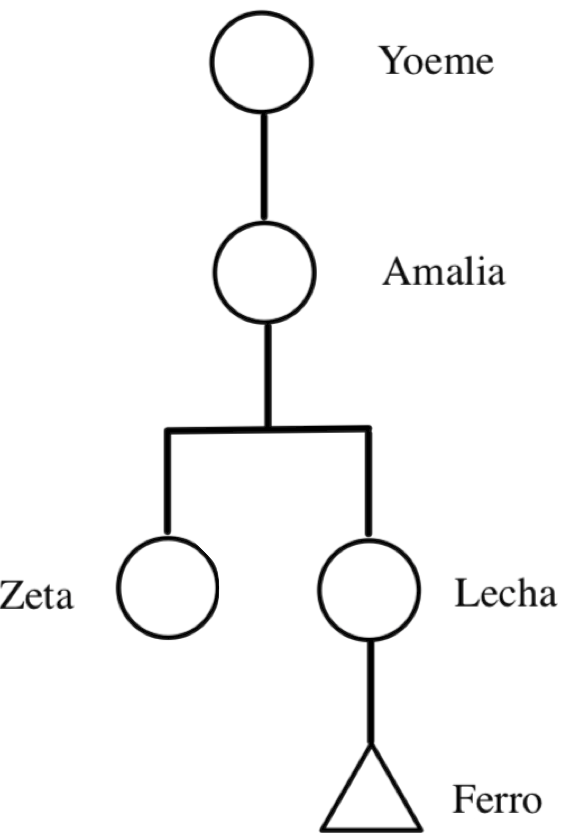
| Lecha |
Lecha
- A “well known psychic ...returning home” now after years of being
away because she is dying of cancer. Lecha “has come home to get things
in order before she died.” She is Zeta's twin sister. She has the
ability to see into people's lives and futures, or what the western
world characterizes as a Psychic. She exploits this gift for some time
in her life, even becoming a TV personality, before she decides to
return to the work left by her grandmother. Lecha is also part of
Calabazas' organization, and has traveled around the Americas. |
不治のがんの罹患。霊能者。自分の死を覚 悟しての帰郷。ゼータの双子の姉妹。Calabazasの家族。祖母Yoemeの仕事を継ぐ。レーチャはテレビに出演して霊能を披露している。彼女が自分 の義務として課しているのは『死者の暦』を記すこと |
| Zeta |
Zeta
- Is Lecha's twin sister. She stayed in Arizona and raised Lecha's son
Ferro. She, before Lecha, decided to return to the work left to them by
their grandmother. Zeta and Lecha's mother was an indigenous women from
Mexico who was impregnated by a white man. After their mother dies the
twins' father returns for a strange short period in their lives. Zeta
also has ties to Calabazas' organization. |
レーチャの双子の姉妹。レーチャと異な り、アリゾナで、レーチャの息子フェロを育てる。祖母Yoemeの仕事を継ぐ。母親のAmaliaは、白人との間に 双子の娘を出産したメキシコ先住民。父親の白人は短期間だが、彼女たちのところに滞在したことがある。Zela は双子の姉妹LechaとともにCalabazasの家族。 |
| Seese |
Seese
- Is a young white woman who was living in San Diego. There she became
an addict and fell in love with a bisexual man named David. They had a
child, which later is stolen and possibly killed. When Seese watches
Lecha on TV she drives to Tucson to find her. |
サンディエゴに住んでいた若い白人女性。 Davidというバイセクシャルの男と恋に落ちる。Seeseはテレビでレーチェを見て、トゥクソン=ツーソン (Tucsón [ˈtukson, tukˈson]、パパゴ語:Cuk Ṣon)に車を走らせ会いにゆく。薬物依存症。 |
| Sterling |
Sterling
- Is an older Laguna Indian from New Mexico who is exiled from his
tribe/community after he fails to protect them from a Hollywood film
crew that disrespect their native lands. He has wandered across the
American southwest since his twenties and loves to read crime histories
of early America. He is recruited by two of Calabazas' men while
drinking at a bar, and works as a gardener for Lecha, Zeta, and
Calabazas. |
ニューメキシコ出身の年配のラグーナイ ンディアンで、故郷を軽視するハリウッドの映画スタッフから彼らを保護できなかったため、部族/コミュニティから追放された。20代からアメリカ南西部を さまよう。バーでカラバサのメンバーと出会い、レチャ、ゼータ、カラバザの庭師として働くことになる。 |
| Yoeme |
Yoeme
- Is Lecha and Zeta's Maya grandmother. She abandoned her family, Lecha
and Zeta's mother, when she was young, because she knew they were not
strong enough to survive the colonial violence of white settlers. Yoeme
returns to the twins' life, teaches them harsh lessons and histories of
the American southwest, and hands them a book she wants them to finish
when it is time. The book is called the Almanac of the Dead. |
-LechaとZetaのMayaの祖 母。白人入植者の植民地時代の暴力から保護するためにアマリアを育てる。彼女は、孫の双子の姉妹を育て、アメリカ南 西部の過酷な教訓と歴史を教え、なんとか完成させたい本を手渡す望みをもっていた。これがAlmanac of Dead である。 |
| Calabazas |
Calabazas
- Is an old Yaqui Indian who has run a clandestine business and
organization between Tucson and Sonora for over 40 years. Lecha was his
lover for a small time, and he has a wife named Sarita. For most of his
married life he desired Sarita's younger sister Liria. |
ツーソンとソノラの間で40年以上秘密の ビジネスと組織を運営してきた古いヤキ族のインディアン。レチャはしばらくの間カラバサスの恋人であった。カラバサスには、妻サリタがいたが、カラバサス はずっと、サリタの妹リリアに思いを募らす。 |
| Ferro |
Ferro
- Is Lecha's son. He was over weight and effeminate as a young boy, and
was teased a lot. He also harbors a lot of resentment for his mother
and Zeta, even though Zeta raised him in the same cold and calculating
ways Yoeme raised her. Ferro is gay and has two lovers: one in his
recent-past named Jamey, and another named Paulie. Ferro also works
with Calabazas. |
レーチャの息子。肥満のため、女々しく そのためにいぢめにあう。レーチャの代わりにゼータが彼を育てるが、フェーロは、自分の母親も育ての母の叔母のことも恨んでいる。フェロは男性同性愛者 で、かつてはジェイミーを、そして現在はポーリーがその恋人である。フェーロはカラバサスを支えて関係は良好。 |
| Paulie |
Paulie
- works at the home Zeta and Ferro live at. He controls the many dogs
on the land. He was in prison with Ferro and is now his lover. |
ポーリーは、ゼータとフェーロが住んでい る家で働いている男。多くの犬を育てている。フェーロの恋人。 |
| David |
David
- Is a bisexual artist from San Diego. He was a former escort before
Beaufrey falls for him and takes care of him. Beaufrey eventually helps
David become a well known artist. David is at the core of a love
triangle with Seese, Eric, and Beaufrey. He and Seese have a child
named Monte, that was more than likely kidnapped and killed by a
jealous Beaufrey. |
サンディエゴからやってきた、バイセク シュアルのアーティスト。Beaufreyが世話をしているが、その前の職業はボディガード。 |
| Eric |
Eric
- Is a young gay man from a conservative family in Texas. He moves to
San Diego to live his truth, but also falls in love with, and becomes a
lover of David's. Like Seese, Eric becomes an addict, and is also hated
by Beaufrey. |
テキサスの保守的な家族の若いゲイの男 性。サンディエゴに移住してきた。デイビッドと恋人になる。薬物依存症のため、ボーフリーには嫌われる。 |
| Beaufrey |
Beaufrey
eventually helps David become a well known artist. David is at the core
of a love triangle with Seese, Eric, and Beaufrey. He and Seese have a
child named Monte, that was more than likely kidnapped and killed by a
jealous Beaufrey. |
ボーフリーは、アーティストのデイビッド の世話をしている。 |
| Jamey |
Jamey - Is Ferro's
handsome lover who is addicted to cocaine. |
コカイン中毒のフェーロのハンサムな恋 人。 |
| Root |
Root
- Is part white, Mexican, and Indian. His mother was a German woman who
married a dark mestizo man in the Army. Root is Lecha's on and off
lover, and highly intelligent. Yet, he had a serious accident that gave
him brain damage and altered his motor functions. Despite his
disabilities Root is one of Calabazas' most trusted transporters. |
白人、メキシコ、インドの混血。彼の母親 は、陸軍で暗いメスティーソの男と結婚したドイツ人の女性。レーチャとの恋人になったり別れたりしている。事故のために脳損傷を受け運動機能を損なう。 ルートは、カラバサス家の重要な薬物の運び屋。 |
| Mosca |
Mosca
- Is a dark skinned Mexican who is also one of Calabazas' transporters.
He loves to drink and do drugs, and is possibly autistic. He is also
fascinated with Root's accident, which he tries to contextualize and
mythologize. |
カラバサス家の薬物の運び屋。肌の色が濃 いメキシコ人。自閉的なところがある依存症。ルートの事故になにか神秘的なものを感じている。 |
| Mahwala |
Mahwala - Is the
eldest of Calabazas' Yaqui tribe. She shares and communicates the
land's and tribe's history to Calabazas. |
ヤキインディアンの、カラバサス家の長 女、土地と部族の歴史をカラバサスに伝える。 |
| Sarita |
Sarita
- is Calabazas' wife from the Brito family in Sonora. Her father
married her to Calabazas to pay a gambling debt. She is also said to be
highly religious (Catholic). |
ソノラのブリート家から嫁いだカラバサス の妻。サリタの父は、ギャンブルのカタに娘のサリタをカラバサスに嫁がせた。敬虔なカトリック。 |
| Liria |
Liria
- is Sarita's younger sister. She is said to have been the one to give
Calabazas his name as a young girl during one of the early transports
between him and their family. |
サリタの妹。カラバサス家の運び屋。カラ バサスが彼女の名前の命名者。 |
| Source:
https://en.wikipedia.org/wiki/Almanac_of_the_Dead |
■ Almanac of the dead, 1991. 登場人物像(パート2:Part Two: MEXICO)
| Menardo |
Menardo - is an
indigenous Mexican from Chiapas. Menardo and his exploits make up the
majority of this part of the text. He is a self-loathing Maya who tries
to conceal any indigenous part of his self and family history. As a
youth he is fat and dark skinned, and therefore teased, so he grows up
with a chip on his shoulder. He starts an insurance company that is
fledgling until a major earthquake hits (a possible allusion by Silko
to the major natural disaster of '85), and Menardo pulls off a
miraculous feat that makes the community members adore him. He gains
many customers and other opportunities open up for him. Even though he
is portrayed a sort of lucky fool, Menardo's wealth only grows. He
marries a woman named Iliana and gains monetary connections from Tucson
to Guatemala. |
|
| Iliana |
Iliana - Is a
local from Tuxtla whose family claims they are direct descendants from
the colonizer Juan De Onate. She grows up spoiled, loves expensive
things, but can't bare children for Menardo. She spends most of her
time with the other wives of El Grupo. Her family hates Menardo. |
|
| Alegria |
Alegria - Is a
woman from Venezuela that was educated in Spain. She looks white and is
a young architect working for a major firm in Mexico City. She is
assigned to build Menardo's lavish house for Iliana. She has a
boyfriend named Bartolomeo that she lives with in Mexico City. Alegria
begins an affair with Menardo as she designs and constructs his home.
Iliana suspects nothing. |
|
| General J |
General J - Is
from Guatemala and part of Menardo's inner circle. He, like others in
the novel, denies he has ties to any indigenous blood. He hates
communism and is actively strategizing with Menardo to quell rising
rebellions within Mexico. He is basically Menardo's muscle, but not in
any way shown to be a subordinate of his. |
|
| Green Lee |
Green Lee - Is an
arms dealer out of Tucson. He is another of Menardo's connections. |
|
| El Grupo |
El Grupo - Is made
up of characters that are just given names like The Police Chief, The
Judge, The Governor, and The Ambassador. They occupy a central place in
this part of the novel as they are the men Menardo is constantly in
communication with about their money, their wives, and the state of
Mexico as a country. |
|
| Angelita La Escapia |
Angelita La
Escapia - Is an indigenous Maya women from Mexico City. She is the head
of a leftist rebel cell that is tracking Menardo's activities. She
reports back to her indigenous community members who grow suspicious of
her love of Karl Marx's book Capital. Her love of Marx is rooted in the
idea that he is the only white man who has ever told the truth, through
rigorous research and evidence, about the savagery of white people and
capitalism. She views Marx through an indigenous lens and constantly
speaks of his materialist short-comings. She is also involved in a
relationship with Bartolomeo, though she is plotting on him as well,
because he is a white Cuban who also thinks indigenous people are
stupid. |
|
| Bartolomeo |
Bartolomeo - is a
white Cuban who runs a communist center in Mexico City. He is supposed
to be sleeping with Alegria to get information for his group about
Menardo and others. He is generally represented as someone who is only
in it for himself. |
|
| El Feo |
El Feo - is from
the same indigenous community as Angelita La Escapia. He was sent to
keep an eye on her, but agrees with the ways she is organizing and
moving forward. |
|
| Tacho |
Tacho - is Menardo
and Iliana's indigenous chauffeur. He deals with Menardo and Iliana's
constant micro-aggressions, but also helps decipher Menardo's constant
surreal and violent dreams. This allows Tacho to keep Macaws in their
back yard. Tacho is depicted observant and calculating. He is tied to
the same cells as Angelita, Bartolomeo, and El Feo. |
■ Almanac of the dead, 1991. 登場人物像(パート3:Part Three: AFRICA)
ニュージャージー、アリゾナ、エルパソの3つのブッ
クから構成される
| Max Blue |
Max Blue - Is a
Vietnam War vet that is known as a mafia figure / boss in New Jersey.
During his time in the war he survived a plane crash, which is a sort
of omen for Max. The opening of Part Three has him surviving an
assassination attempt that kills his brother Bill. These events are
said to change Max and make him retire from organized crime. He moves
his family to Tucson, where he spends all his time playing golf. |
ベトナム帰還兵 |
| Leah |
Leah - Is Max's
wife. She works in real estate and constantly cheats on Max, because he
has no interest in having sex with her. Max knows of Leah's
infidelities and does not care. Though she is not fond of Arizona, Leah
does manage to hustle and obtain large amounts of valuable property in
the area. |
|
| Trigg |
Trigg - Is an alcoholic
businessman who lost his ability to walk in a car accident. Trigg is
also a racist and sexist that becomes Leah's primary lover. He is so
obsessed with power and regaining his ability to walk, that he builds a
blood and organ bank with the help of his assistant Peaches and a
homeless veteran named Roy. Ultimately, readers come to find that Trigg
has other means to gain donors to his organ and blood banks. |
|
| Rambo-Roy |
Rambo-Roy - Is also a Vietnam
War vet. He works for Trigg, but uses the money he makes to organize
other homeless men, veterans in particular, because he has a vision to
build an army to overthrow the government. He does not trust Trigg and
has a crush on the assistant Peaches. |
ベトナム帰還兵 |
| Clinton |
Clinton - Is the third Vietnam
War vet we come to know in the section. Clinton is also the first
central Black character of the novel. Like Roy, he is homeless, and
they become partners in plotting a resistance. Clinton's focus is on
liberating Black Americans from the shackles of American historical,
religious, and economic bondage. Outside of Max Blue, Clinton is the
most prominent figure of Part Three. He retells not only how he
survived Vietnam, but of his days in college, the history of Black
Indians, and how he looks to center pre-colonial African spirituality
in his daily life. |
|
| Sonny Blue |
Sonny Blue - Is Max's son, but
Leah is not his biological mother. He had inherited a small portion of
the family's business running slots and vending machines. Yet, this is
not enough for Sonny so he negotiates a guns and drugs deal with people
in Mexico. Sonny is also cruel to Leah and his younger brother, and
like many other characters an overt sexist and racist. |
|
| Bingo |
Bingo - Is Max's other son, who
is not only picked on by Sonny, but is pathetically mediocre in all
parts of his life. He developed a cocaine addiction once he found out
about his father's life and business. Alongside his brother he cares
for the slots and vending machines. |
|
| Angelo |
Angelo - Is Max and Leah's
nephew. Angelo's father did not want to be part of the family business,
but he does. Angelo begins to work with his cousin Sonny, but Bingo
does not trust the woman Angelo is in love with. Angelo also believes
Sonny is money hungry and untrustworthy. |
|
| Marilyn |
Marilyn - Is the woman Angelo is
in love with. She also seems to have strong feelings for him, but
chooses to go back to be with her husband. |
|
| Peaches |
Peaches - Is Trigg's assistant.
She knows all of his secrets and hints at them to Roy. Peaches is smart
and calculating. |
|
| Judge Arne |
Judge Arne - Is caught up in
small scandal tied to Ferro's lover Jamey. He is not worried about it
though, because Arne has found someone else who he can place stronger
blame on. Judge Arne also plays golf with Max Blue. |
|
| Source: https://en.wikipedia.org/wiki/Almanac_of_the_Dead |
■ Almanac of the dead, 1991. 登場人物像(パート4:Part Three: AFRICAPart Four: THE AMERICAS)
■ Almanac of the dead, 1991. 登場人物像(パート5:)
■ Almanac of the dead, 1991. 登場人物像(パート6:)
| Wacah |
||
| El Feo |
||
| Angelita |
||
| Wilson Weasel Tail |
poet lawyer, p.713 |
|
| the Hopi |
||
+++
●著者およびその他の作品
Leslie Marmon Silko (born Leslie Marmon; born March 5, 1948) is a Laguna Pueblo writer and one of the key figures in the First Wave of what literary critic Kenneth Lincoln has called the Native American Renaissance. - "Leslie Marmon Silko"
The follwing informations are cited from Wikipedia article on "Leslie Marmon Silko"
"The main plot line of Ceremony follows the trials of a half-Pueblo, half-white Laguna Pueblo man named Tayo upon returning from World War II. His white doctors say he is suffering from "battle fatigue," or what would today be called post-traumatic stress disorder. However, the novel interweaves several different timelines around Tayo, from both before and after the war, as well as a spiritual timeline where the Thought Woman (also known as Spider Woman), Corn Woman and Reed Woman, the three main Pueblo spiritual entities, create the world and then Hummingbird and Green Bottle Fly must go down to the Fourth World to retrieve Reed Woman to stop a drought. Also in this spiritual timeline is the introduction of the "witchery" and the "destroyers," who are like anti-medicine men, sewing evil and destruction which the medicine men work to fight against through Ceremony. By the end of the novel, all of these timelines converge in the ceremony of Tayo."
リンク
文献
- アメリカ・マイノリティ女性文学と母性 : キングストン、モリスン、シルコウ / 杉山直子著,彩流社 , 2007
- 悲しきインディアン / レスリー・マーモン・シルコウ著 ; 荒このみ訳,晶文社 , 1982(後に、講談社文庫で出版される『儀式』1998年、は同じ内容で同じ訳者によるもの)
- Gardens in the dunes : a novel / Leslie Marmon Silko, New York : Simon & Schuster , 2000. - (Scribner paperback fiction)
- Marginal voice, marginal body : the treatment of the human body
in the works of Nakagami Kenji, Leslie Marmon Silko, and Salman Rushdie
/ by Noriko Miura, Ann Arbor, Mich. : UMI , c1996
その他の情報
